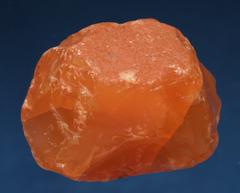last modified: Tuesday, 26-May-2009 03:44:48 CEST
Document status: incomplete
|
Carnelian is a translucent, bright orange to deeply red chalcedony. Strictly spoken, it should not be banded or striated, but very often it is just the orange-red part cut out of a large agate. The name refers to its flesh-red color. It is sometimes also called cornelian or cornaline. The image to the right shows a rough carnelian of unknown origin.
Sard is a translucent, brown chalcedony. It should not be banded or striated, but very often it is just a brown portion cut out of a large agate. It's also only the tone of the color that distinguishes sard from carnelian, the latter being more orange-red. It's also only the tone of the color that distinguishes carnelian from sard, the latter being more brown. |

10mm 850x682 59kb - 1700x1364 183kb |
Specific Properties
The color of carnelian and sard is caused by embedded iron compounds, the more yellow to brown tones by hydrous iron oxides and the valued red tones by iron oxides. The distribution of the color is sometimes cloudy, but good specimen have an even coloration. Carnelian and sard cut out of agates is usually banded.Brighter brownish or yellowish stones are sometimes heated to convert the hydrous oxides into simple oxides, as their red color is more valued.
->Bauer reports that deeply red carnelian has also been produced by heating greenish to black chalcedony in Ratanpur in India.
Carnelian and sard can be found as irregular or as spherical nodules that fill out former gas cavities in volcanic rocks.
Occurrence
Carnelian and sard can be found in the same environments as agate and chalcedony, often along with them. They form as a secondary product in volcanic rocks, usually as nodules in basalts.Locations and Specimen
Further Information, Literature, Links
 Printer Friendly Version
Printer Friendly VersionCopyright © 2005-2013, A.C. A k h a v a n
Impressum - Source: http://www.quartzpage.de/carnelian.html
